Using SecurDisc to password-protect files and folders
 Would you like to be able to put data files on your CDs and DVDs and password protect them so that only you can view and edit them? SecurDisc makes this possible. SecurDisc ensures the protection of confidential data by encrypting through AES-128. This prohibits access to the protected data without the password set by the original author.
Would you like to be able to put data files on your CDs and DVDs and password protect them so that only you can view and edit them? SecurDisc makes this possible. SecurDisc ensures the protection of confidential data by encrypting through AES-128. This prohibits access to the protected data without the password set by the original author.
SecurDisc is a hardware-software based solution, and is therefore harder to hack and more secure than software-only solutions. Not only is the password protection feature secured by the AES-128 encryption, but secret values are also implemented in a drive's firmware to provide extra security.
Nero Express settings for Password Protection
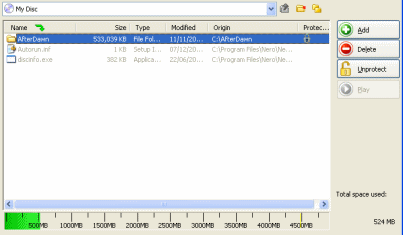 Start a new compilation and Add files and folders to it as we did before. For me, I have added the AfterDawn folder again. What I am going to do now, is password protect the entire AfterDawn folder and all of its subfolders and files.
Start a new compilation and Add files and folders to it as we did before. For me, I have added the AfterDawn folder again. What I am going to do now, is password protect the entire AfterDawn folder and all of its subfolders and files.
SecurDisc allows me to set a password that is at least 16 characters long, but can be a full sentence if wanted. I can pick and choose what to protect and what not to protect too, by simply clicking on any folder or file and click the Protect button.
If you make a mistake, simply clicking Unprotect will remove the password restriction (password itself is set soon).
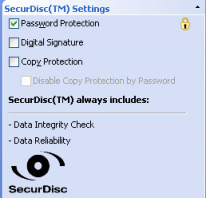 You will notice that as soon as you press the protect button on any folder, the Password Protection option will be ticked now under the SecurDisc settings on the left hand side of Nero Express. For now, we will leave Digital Signature and Copy Protection alone, and see what happens when we try to add a password.
You will notice that as soon as you press the protect button on any folder, the Password Protection option will be ticked now under the SecurDisc settings on the left hand side of Nero Express. For now, we will leave Digital Signature and Copy Protection alone, and see what happens when we try to add a password.
When you have selected all the folders you want to be password protected, click the Next button.
Set the password
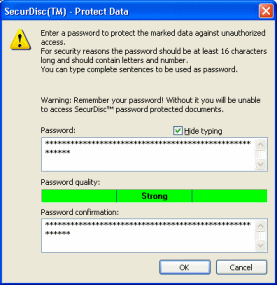 You will now be prompted to provide a password. It must be at least 16 characters long and it can include spaces. It is a good idea with SecurDisc to use a full sentence that you will not forget as your password. This will guarantee a strong password, but make sure you DO NOT forget the password later on, trust me, I managed to forget it the first time I used this feature.
You will now be prompted to provide a password. It must be at least 16 characters long and it can include spaces. It is a good idea with SecurDisc to use a full sentence that you will not forget as your password. This will guarantee a strong password, but make sure you DO NOT forget the password later on, trust me, I managed to forget it the first time I used this feature.
If you forget it, there is no "Forgot your password?" link to rely on, you simply just can't access the data now and good luck trying to crack it. You just type your password twice to make sure that you got it right. When you are done click OK.
Giving your disc a label
 The next step is to give your disc a label, this is straight-forward, just type in whatever you want. AD Backup for me is appropriate.
The next step is to give your disc a label, this is straight-forward, just type in whatever you want. AD Backup for me is appropriate.
When done here, click Burn.
Password Protection in event log
 The Nero Express Event Log should now show Password Protection is present during the burning process. Again, the Data Reliability and Integrity feature is constantly on and will ensure that the disc is filled right to the edge for better data security.
The Nero Express Event Log should now show Password Protection is present during the burning process. Again, the Data Reliability and Integrity feature is constantly on and will ensure that the disc is filled right to the edge for better data security.
The burn process will finish, you will receive a report on the SecurDisc features on the disc. When you are done with that, remove the disc from your drive and re-insert it, and let's see what happens.
SecurDisc Technology Detected?
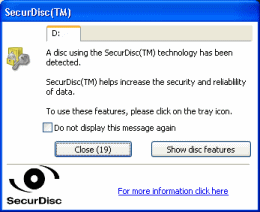 Once the disc is inserted, the drive will notice that SecurDisc features are detected and now InCD comes into play. From your system tray, you will receive a notice that SecurDisc features have been detected as present on the disc you just inserted.
Once the disc is inserted, the drive will notice that SecurDisc features are detected and now InCD comes into play. From your system tray, you will receive a notice that SecurDisc features have been detected as present on the disc you just inserted.
The reason this will pop up this time is that you are using Password Protection and so your input will be required in order to view the protected content on the disc. In fact, a password prompt may pop up all by itself for you to enter your password now.
Firstly though, let's see how well InCD reads the disc by clicking Show disc features.
Disc features
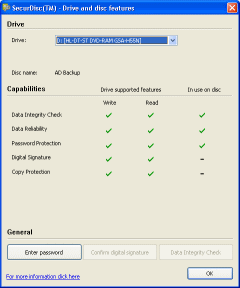 A window will now pop-up showing you what SecurDisc features the drive you have inserted the disc into can be using in writing and reading the disc and also the features currently in use on the inserted disc.
A window will now pop-up showing you what SecurDisc features the drive you have inserted the disc into can be using in writing and reading the disc and also the features currently in use on the inserted disc.
In our example here, there should be three features in effect with the disc, Data Integrity, Data Reliability and Password Protection. If you have not already gotten a window asking you to insert a password, then click the Enter password button on this window.
Enter your password
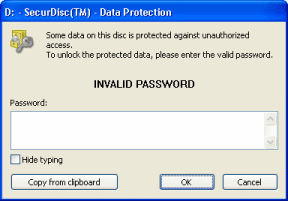 Hopefully you can remember your password. If you don't remember your password then you will get the big black letters saying "Invalid Password" like in the example image here.
Hopefully you can remember your password. If you don't remember your password then you will get the big black letters saying "Invalid Password" like in the example image here.
What would happen if you don't know your password anyway? Are the files still viewable? Can they be accessed using another non-SecurDisc drive? Well let's see. Go to your My Computer and right click on the DVD drive and click Open.
Find a folder you password protected and now double click it.
Viewing inside Password Protected folders
 As you can see yourself now, or from the sample picture, yes you can see the filenames inside the password protected folder. Is this a failure or an oversight on the part of SecurDisc? Well, not at all really. Try opening any of the files.
As you can see yourself now, or from the sample picture, yes you can see the filenames inside the password protected folder. Is this a failure or an oversight on the part of SecurDisc? Well, not at all really. Try opening any of the files. What you will now receive is a message saying that the files cannot be opened because the user has failed to provide key data for the encrypted content. Even without the InCD service, the files remain encrypted on the disc and so you cannot open them without the password, or unless you somehow manage to break the AES-128 encryption in use.
What you will now receive is a message saying that the files cannot be opened because the user has failed to provide key data for the encrypted content. Even without the InCD service, the files remain encrypted on the disc and so you cannot open them without the password, or unless you somehow manage to break the AES-128 encryption in use.
Remember that you can always right click on the InCD icon in the systray to enter the password needed for the disc, so don't worry if you closed the prompt to enter it already.
Next
So now we have seen how SecurDisc strengthens the possibility of recovering data from a disc, how it determines that data is at risk and how it can password protect folders and files to keep away prying eyes. So what is next? How about a way to determine is a disc came from the correct source and that you were not duped? Let's take a look at Digital Signatures.
Written by: James Delahunty

